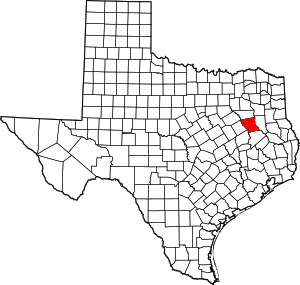Cayuga, Texas
Cayuga is an unincorporated community in northwestern Anderson County, Texas, United States.[1] According to the Handbook of Texas, the community had a population of 200 in 2000. It is located within the Palestine, Texas micropolitan area.
Cayuga, Texas | |
|---|---|
 Cayuga, Texas Location within the state of Texas  Cayuga, Texas Cayuga, Texas (the United States) | |
| Coordinates: 31°57′26″N 95°58′29″W | |
| Country | United States |
| State | Texas |
| County | Anderson |
| Elevation | 308 ft (94 m) |
| Time zone | UTC-6 (Central (CST)) |
| • Summer (DST) | UTC-5 (CDT) |
| ZIP codes | 75832 |
| Area code(s) | 430 & 903 |
| GNIS feature ID | 1379518[1] |
History
Cayuga was first settled in the 1840s. The ghost town of Wild Cat Bluff was considered a forerunner of the community, and served as a shipping point for farmers living in the community since it was extremely close to the community along the Trinity River. This community flourished briefly when traffic along the Trinity River was navigable, but then began to decline in the early 1870s when navigation along the river became no more. Afterwards, Cayuga began to come alive by the 1880s. A post office was established at Cayuga in 1894, and W.A. Davenport became the first postmaster after moving to the community from his native Cayuga, New York. He also operated a steam barge on the Trinity for several years. It shipped cotton, cross ties, and staves to the port city of Galveston. The Judson Baptist Church became the first church to be established in the community in 1854. A church called the Joppa Holiness Church held services in the settlement from 1899 to 1907, and another church called Freeman Baptist Church opened in 1910 and held services in the community until 1934. It remained a small farming community that same year. The discovery of oil by the Tidewater Oil Company in a field named J.N. Edens No. 1., caused Cayuga to become an oil boomtown overnight, and it had over 1,000 residents and 15 businesses by 1936. It began to go away after World War II, and the community's population plunged to 200 by 1952. It plunged again to 56 residents by 1974, and only two businesses were located in the community. The community was revived when the Richland-Chambers Creek Reservoir was discovered in nearby Freestone and Navarro counties and when four state prisons were established in the area. Large lignite reserves were discovered in the area not long after. Approximately 700 people lived in Cayuga in 1988, and there were several businesses, which included offices of two major petroleum companies in the area. The population plunged to a paltry 56 in 1990, and grew to 200 in 2000.[2]
Although it is unincorporated, Cayuga has a post office, with the ZIP code of 75832.[3]
Geography
Cayuga sits along the junction of U.S. Highway 287 and Farm to Market Road 59, 5 mi (8.0 km) east of the Trinity River in northwestern Anderson County.[2]
Education
The first school established in Cayuga was taught by a man named G.W. Tuggle, who was also the chief justice of Anderson County. He and his wife, Elizabeth Tuggle, were given a half an acre of land near Tuggle Springs for the school campus on May 7, 1860. It remained standing at that spot until it was moved to the Cayuga-Blackfoot road in the 1880s. It was then moved to an unknown location just off Farm to Market Road 59 in 1922, after they had a bad argument. In 1974, the school closed and kids began attending school in nearby Bethel.[2] Today the community is served by the Cayuga Independent School District.
